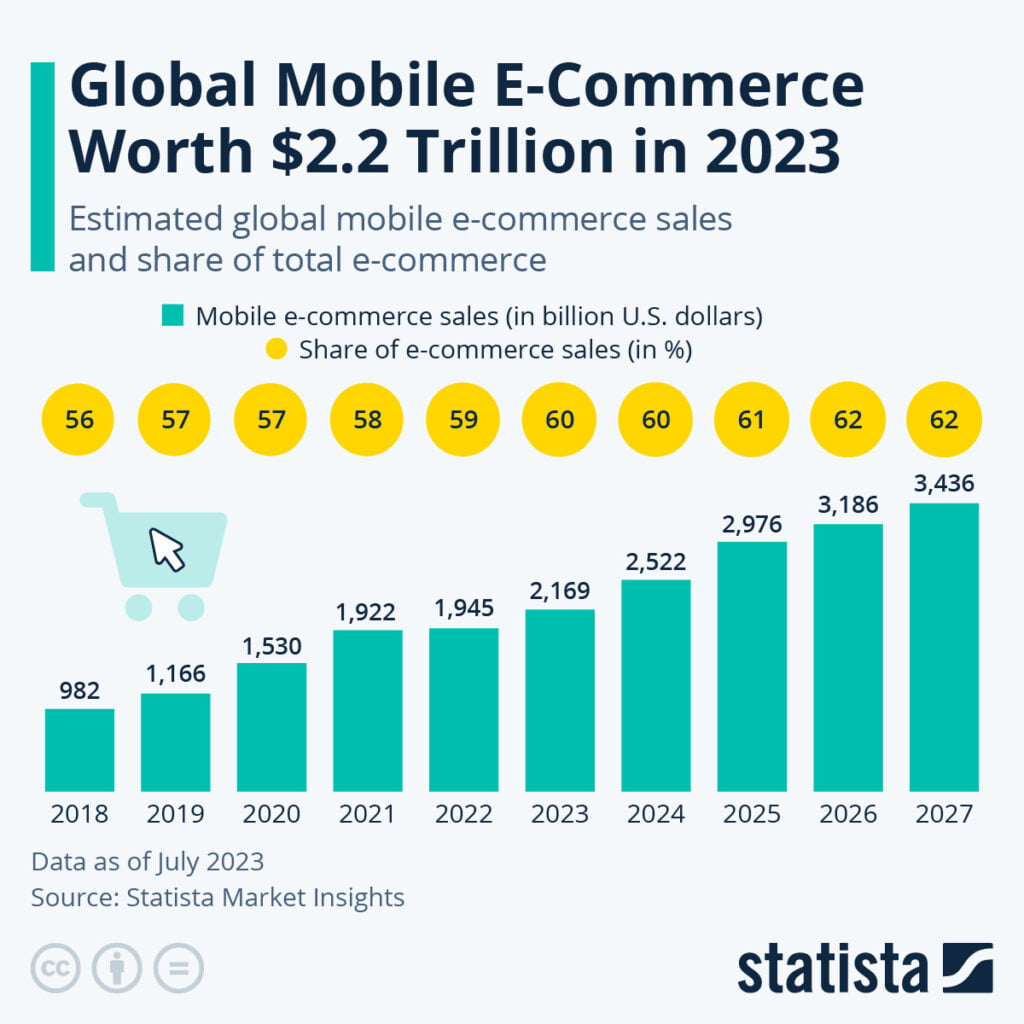Mobile commerce, often referred to as m-commerce, is transforming the retail industry. With smartphones becoming an integral part of our daily lives, the way consumers shop should also adapt.
This article will explore the growth and impact of mobile commerce.
What is mobile commerce?
Mobile commerce, or m-commerce, involves using mobile devices to conduct commercial transactions online. It includes a wide range of transactions, from online shopping to banking, and even booking travel tickets.
The growth of mobile commerce
Mobile commerce is experiencing rapid growth, outpacing traditional e-commerce. Here are some key statistics that illustrate this trend.

- Market size: According to Statista, global mobile commerce sales reached $2.2 trillion in 2023
- Share of e-commerce: Mobile commerce accounts for nearly 60% of global e-commerce sales.
- User base: Another report by Statista indicates that in US in 2024, approximately 187.5 million will have made at least one purchase via web browser or mobile app on their mobile device.
Technical innovations driving mobile commerce
Several technological advancements are fueling this growth, each presenting unique opportunities and challenges.
1. Mobile payment technologies
The backbone of mobile commerce lies in secure, efficient mobile payment technologies:
- Near Field Communication (NFC)
NFC enables contactless payments. It allows consumers to make purchases with just a tap of their smartphone. Services like Apple Pay and Google Wallet use NFC to offer uninterrupted transactions. - Digital wallets
Talking about digital wallets – they securely store payment information, facilitating quick transactions. They are integrated with mobile apps to offer one-click purchases, enhancing the user experience. - Cryptocurrency integration
With blockchain technology gaining traction, integrating cryptocurrency payments into mobile commerce systems offers an alternative payment method that appeals to tech-savvy consumers.
2. Advanced security protocols
Security remains a top priority in mobile commerce, with several technologies employed to safeguard transactions.
- Encryption
End-to-end encryption ensures that sensitive data is protected during transmission, making it inaccessible to unauthorized parties. - Biometric authentication
Fingerprint scanning and facial recognition add an extra layer of security by verifying the user’s identity before completing transactions. - Tokenization
Tokenization replaces sensitive card information with a unique identifier, or token, reducing the risk of data breaches.
3. Artificial Intelligence (AI) and Machine Learning (ML)
AI and machine learning help providing personalized shopping experiences.
- Predictive analytics
Machine learning algorithms analyze consumer behavior to predict future purchases and recommend products. - Chatbots and virtual assistants: AI-powered chatbots provide instant customer support and assistance, improving the overall shopping experience.
- Dynamic pricing: AI algorithms adjust prices in real time based on demand, competition, and consumer behavior, optimizing profitability.
Data analytics in mobile commerce
Data is at the heart of mobile commerce. Businesses leverage analytics to gain insights into consumer behavior and optimize operations.
- Customer insights
Analyzing customer data allows businesses to understand purchasing patterns, preferences, and trends, enabling targeted marketing strategies. - Performance metrics
Tracking metrics such as conversion rates, cart abandonment rates, and average order value provides insights into the effectiveness of mobile commerce strategies. - Inventory management
Real-time data analytics help businesses optimize inventory levels, reducing overstocking or stockouts.
Benefits of mobile commerce
For businesses, mobile commerce offers several advantages that make it a crucial part of any retail strategy.
1. Enhanced Customer Experience
Mobile commerce allows for a more personalized shopping experience. With the use of apps and mobile-friendly websites (including PWA), businesses can provide:
- tailored recommendations
- faster checkout processes
- seamless navigation
All of the above enhance customer satisfaction.
2. Increased reach and accessibility
Smartphones are omnipresent, giving businesses the ability to reach a wider audience. This is particularly beneficial in emerging markets where mobile devices are often the primary means of accessing the internet.
3. Improved customer engagement
Push notifications, in-app messaging, and mobile-friendly loyalty programs help businesses engage with customers more effectively. These tools enable real-time communication and offer personalized promotions, driving higher conversion rates.
Challenges in mobile commerce
Despite its many advantages, mobile commerce also presents certain challenges.
1. Security concerns
With the rise in mobile transactions, there is an increased risk of cyberattacks. Businesses must invest in robust security measures to protect sensitive customer data.
2. Technical issues
Ensuring a seamless mobile experience requires addressing various technical challenges, such as:
- page load speeds
- app compatibility
- maintaining a user-friendly interface across different devices.
3. Market competition
The rapid growth of mobile commerce means that the market is becoming increasingly competitive. Businesses need to continuously innovate and offer unique value propositions to stand out.
4. Cross-platform compatibility
Ensuring a seamless experience across different devices and operating systems is critical. Businesses must invest in responsive design and app development to cater to various platforms.
5. Network reliability
Mobile commerce relies heavily on network connectivity. Ensuring fast, reliable access to services, even in low-bandwidth environments, is essential for maintaining user satisfaction.
Strategies for success in mobile commerce
To capitalize on the potential of mobile commerce, businesses should consider the following strategies.
1. Optimize website for mobile devices
The simplest, but one of the most powerful. Ensure that your website and online store are mobile-friendly. This includes responsive design, fast loading times, and intuitive navigation.
2. Invest in a mobile app
A dedicated mobile app can provide a superior user experience compared to a mobile website. It allows for better personalization, faster transactions, and enhanced engagement through push notifications. Today’s technology allows for creating one app, that works on different platforms.
3. Go for emerging technologies
Adopting technologies such as 5G, augmented reality (AR), and blockchain can provide competitive advantages by enhancing the user experience and offering innovative solutions.
4. Prioritize Security and Compliance
Implement robust security measures and ensure compliance with data protection regulations to build consumer trust and protect the business from cyber threats.
5. Leverage cloud computing
Cloud-based solutions offer scalability and flexibility, allowing businesses to effectively manage large volumes of data and transactions.
Future of mobile commerce
The future of mobile commerce looks promising, with several trends set to drive its continued growth.
- Augmented Reality (AR)
AR technology can enhance the shopping experience by allowing customers to visualize products in their real environment before making a purchase. - Voice commerce
With the increasing popularity of voice assistants like Siri and Alexa, voice commerce is expected to become a significant component. - 5G Technology
The rollout of 5G networks will provide faster and more reliable internet connections, further enhancing the mobile shopping experience. - Internet of Things (IoT)
IoT devices will enable integration between physical and digital shopping experiences, offering personalized and context-aware services.
Conclusion
Mobile commerce is reshaping the business landscape, offering unprecedented opportunities and challenges. Understanding its potential is essential for staying competitive. By investing in the right strategies, businesses can position themselves for success in the era of mobile commerce.
GET IN TOUCH
Looking for an expert to implement this technology?
Let’s discuss your ideas and find out how we can help!
Mobile commerce FAQs
What is the difference between e-commerce and mobile commerce?
E-commerce refers to buying and selling goods and services online, while m-commerce involves transactions conducted via mobile devices like smartphones and tablets. M-commerce focuses on providing a seamless shopping experience optimized for mobile users.
How does mobile commerce improve customer engagement?
Mobile commerce improves customer engagement by leveraging technologies such as push notifications, personalized recommendations, and in-app messaging. These tools enable businesses to communicate directly with customers, offer tailored promotions, and enhance the overall shopping experience.
What role does AI play in mobile commerce?
AI plays a crucial role by enabling personalized shopping experiences, predictive analytics, and dynamic pricing. AI-powered chatbots and virtual assistants also provide real-time customer support, improving the efficiency of mobile commerce platforms.
How can businesses ensure data privacy in mobile commerce?
To ensure data privacy, businesses should implement robust security measures such as encryption, tokenization, and biometric authentication. Compliance with data protection regulations like GDPR and CCPA is also essential to protect consumer data and maintain trust.
What are some emerging technologies that will impact mobile commerce?
Emerging technologies such as 5G, augmented reality (AR), blockchain, and the Internet of Things (IoT) are set to impact it significantly. These technologies will enhance user experiences, improve transaction security, and enable more personalized and context-aware shopping.























